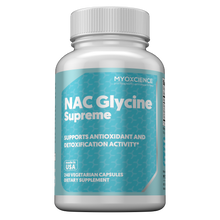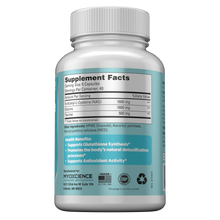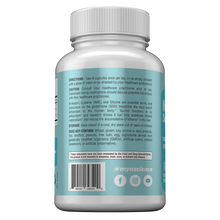N-Acetyl-L-Cysteine and may support glutathione production, immune defense, and detoxification‡
Product Highlights:
-
1.6 grams of both NAC per serving
- 1.6 grams of Glycine per serving
-
Restores and promotes glutathione synthesis*
-
Promotes antioxidant defenses and the body’s natural detoxification process*
-
Enhances immune defense and supports respiratory health*
Serving Size: 6 capsules
Servings Per Container: 40
| Amount Per Serving | %Daily Value | |
|---|---|---|
|
N-Acetyl-L-Cysteine |
1,600 mg (1.6 grams) | ** |
|
Glycine |
1,600 mg (1.6 grams) | |
|
Taurine |
500 mg |
Why This Formula?
NAC (N-acetyl-cysteine) NAC, a sulfur-containing derivative of the amino acid L-cysteine, supports antioxidant and detoxification mechanisms in the body. NAC supports antioxidant activity by neutralizing hydrogen peroxide, hypochlorous acid, and the highly reactive hydroxyl radical and also serves as a source of sulfhydryl groups. In addition, NAC enhances production of the tripeptide glutathione—a key component of both antioxidant and detoxification enzymes.*[1]
NAC is recognized for its support of normal mucous production and may positively support respiratory function and eye health, especially when consumed over a prolonged period.[1-3] Research suggests that NAC may protect cell and tissue health by supporting normal metal status in the body.*[1,4,5]
Glutathione While the absorption of oral glutathione may be limited,[6] supplementation with NAC may significantly increase circulating levels of glutathione in the body.[7,8] Once NAC promotes production of glutathione, glutathione is incorporated into crucial antioxidant enzymes (e.g., glutathione peroxidase and glutathione reductase) and detoxification enzymes (glutathione S-transferases). Through the activity of these enzymes, glutathione directly supports antioxidant activity, phase II detoxification, and the normal breakdown of metabolites, toxins, and other compounds in the body. Glutathione also participates in fatty acid synthesis and amino acid transport across the cell membrane.*[1]
A variety of factors may determine glutathione requirements, including level of exposure to toxins, increased phase I detoxification activity, and overall need for antioxidant support. Maintaining glutathione levels may be important to maintaining the health of the respiratory, hepatic, and immune systems, as well as supporting antioxidant protection of lipids and proteins and supporting the normal response to inflammation.[7-13] Levels of endogenous antioxidants, including glutathione, may decrease with age.[14] It is important to maintain adequate levels of glutathione in the body to support overall health and well-being throughout the lifespan.*
References
1. Krinsky DL, LaValle JB, Hawkins EB, et al. Natural Therapeutics Pocket Guide. 2nd ed. Hudson (OH): Lexi-Comp; 2003.
2. Grandjean EM, Berthet P, Ruffmann R, Leuenberger P. Efficacy of oral long-term N-acetylcysteine in chronic bronchopulmonary disease: a meta-analysis of published double-blind, placebo-controlled clinical trials. Clin Ther. 2000 Feb 22(2):209-21. [PMID: 10743980]
3. Yalçin E, Altin F, Cinhüseyinoglue F, et al. N-acetylcysteine in chronic blepharitis. Cornea. 2002 Mar;21(2):164-8. [PMID: 11862087]
4. Ottenwalder H, Simon P. Differential effect of N-acetylcysteine on excretion of the metals Hg, Cd, Pb and Au. Arch Toxicol. 1987 Jul;60(5):401- 2. [PMID: 3662815]
5. Keogh JP, Steffen B, Siegers CP. Cytotoxicity of heavy metals in the human small intestinal epithelial cell line I-407: the role of glutathione. J Toxicol Environ Health. 1994 Nov;43(3):351-9. [PMID: 7966443]
6. Witschi A, et al. The systemic availability of oral glutathione. Eur J Clin Pharmacol. 1992;43:667-9. [PMID: 1362956]
7. De Rosa SC, et al. N-acetylcysteine replenishes glutathione in HIV infection. Eur J Clin Invest 2000 Oct;30(10):841-2. [PMID: 11029607] 8. Atkuri KR, Mantovani JJ, Herzenberg LA, et al. N-Acetylcysteine—a safe antidote for cysteine/glutathione deficiency. Curr Opin Pharmacol. 2007 Aug;7(4):355-9. Review. [PMID: 17602868]
9. White AC, Thannickal VJ, Fanburg BL. Glutathione deficiency in human disease. J Nutr Biochem. 1994;5:218-26. http://www.sciencedirect. com/science/article/pii/0955286394900396 Updated January 27, 2003. Accessed February 27, 2012.
10. Pace GW, Leaf CD. The role of oxidative stress in HIV Disease. Free Rad Biol Med. 1995;19:523-8. [PMID: 7590404]
11. Favier A, Sappey C, Leclerc P, et al. Antioxidant status and lipid peroxidation in patients infected with HIV. Chem Biol Interact. 1994 Jun;91(2-3):165-80. Review. [PMID: 8194133].
12. Nakamura H, Masutani H, Yodoi J. Redox imbalance and its control in HIV infection. Antioxid Redox Signal. 2002 Jun;4(3):455-64. [PMID: 12215212]
13. Roberts RL, Aroda VR, Ank BJ. N-acetylcysteine enhances antibody-dependent cellular toxicity in neutrophils and mononuclear cells from healthy adults and human immunodeficiency virus-infected patients. J Infect Dis. 1995 Dec;172(6):1492-502. [PMID: 7594708]
14. Hu HL, Forsey RJ, Blades TJ, et al. Antioxidants may contribute in the fight against ageing: an in vitro model. Mech Ageing Dev. 2000 Dec 20;121(1-3):217-30. [PMID: 11164475]
*These statements have not been evaluated by the Food and Drug Administration. These products are not intended to diagnose, treat, cure, or prevent any disease.






